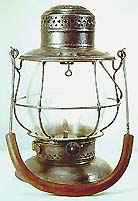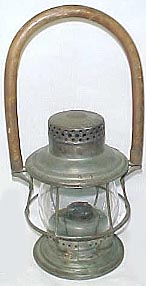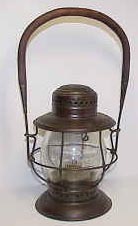Questions & Answers |
Buying & Selling |
General Information |
Switchman
Lanterns
|
||||||
 |
| Above: A Dietz "X.L.C.R." {Excelsior} Switchman's lantern with an insulated bail. |
 |
| Above: An Adams & Westlake #90 switchman's lantern with a rigid wooden bail. Below: A T.L. Moore switchman's lantern with a rigid wooden bail. |
 |
Railroad workers had many different jobs and job classifications. Along with the more commonly known jobs of engineer, conductor, and brakeman was the lesser-known category of switchman. In the early part of the 1900's, switchmen had their own union, work rules, and even job locations that were different from those of other railroad workers. Switchmen's jobs, although much the same as brakemen's, generally restricted them to railroad yards or industrial tracks near the yards. As such they developed certain skills that required a lot of night work and that made extensive use of lanterns. For example, in 1918, the Southern Pacific used a five-man switch crew (engineer, fireman, two switchmen, and a switch foreman), so a lot of lanterns were needed.
In the late 19th century, lantern manufacturers, responding to a need first put forward by switchmen themselves, began to make and sell lanterns explicitly identified as "switchmen's lanterns." Most major railroad lantern makers sold lanterns of this type. Although switchmen's lanterns used the same 5 and 3/8" globe as contemporary brakemen's lanterns, they were unique in that the lantern frame was lighter and smaller, about the same size and, in some cases, even smaller than the the later short-globe kerosene lanterns. Many switchmen's lanterns also did not have a swinging bail but rather had a rigid wooden or steel bail. This allowed the switchman to tuck the bail under his arm while working, especially while on a ladder or on top of a railroad car.
Many of the first switchmen's lanterns used a drop-out pot sometimes called a "Sangster fount" (named for the inventor). However, it was fairly hard to adjust the wick, especially while in motion, and many pots actually did drop out unexpectedly, sometimes setting fire to the landscape. The T.L. Moore lantern partly solved this problem by making it possible to adjust the wick without removing the pot; however, a loose pot could still fall to the ground. The arrival of pots that dropped in from the top of the lantern, the so-called "insert fount", was a great improvement, and railroad lanterns of all types eventually converted to this style. The T.L. Moore Company was a holdout in this regard, and there are no known examples of insert founts in Moore lanterns.
While on the subject of Moore lanterns, this company was unique and has an interesting story. Unlike most lantern companies which were major manufacturing concerns, the T.L. Moore Company was primarily a single individual by that name. Moore's lanterns were actually made by the Star Headlight and Lantern Company. Moore himself had been a switchman who had been injured on the job and who needed some other way to make a living. Through some connections with the union and pure guts, he started selling his lanterns from union hall to union hall throughout the Southwest. Since these lanterns were sold directly to individuals rather than railroad companies, employees took the lanterns with him when they moved on. Moore's lanterns did not come with a globe nor were they marked for a railroad company. As a result, all kinds of marked globes are found with surviving (unmarked) T.L. Moore lanterns, and the markings on these globes are almost always from Southwestern railroads.
Following is a list of switchmen's lanterns that we have seen, with the manufacturer in bold type. The type of bail and dates of manufacture are also listed, although these are meant as examples and not as an exhaustive list.
Adams and Westlake
Dietz
Handlan
Star Headlight
T.L. Moore
*Note: This is the same lantern as sold by T.L. Moore.)